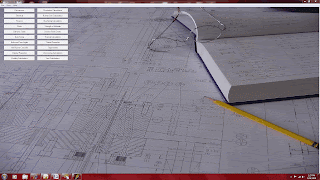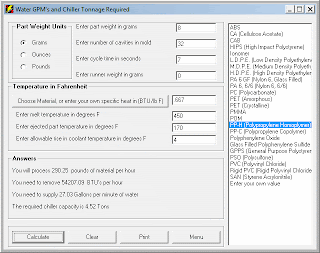You can calculate your required chiller tonnage, gallons per minute of water cooling, and amount of material to be processed per hour in one quick step with DZynSource Mold Engineering Software.
From the main menu, choose the "Thermal Considerations" command button. This is one of the few calculations that can be chosen from more than one sub-menu within DZynSource. It can also be found under the "Molding Calculations" sub-menu.

The blank form for doing this particular production calculation is fairly self explanatory. You first choose the unit of weight for the plastic molded part. In my experience, the part weight is usually measured in grams. The industry that I work in, caps and closures, packaging, medical disposables, and so forth, the parts are fairly small and usually measured in grams. The ounces and pounds are there for the molders, moldmakers and other personnel that work with the larger parts. So, choose the unit of measurement for the part weight, enter the number of cavities in the mold, and enter the cycle time in seconds. If the mold is full hot runner, then there will be no cold runner to allow for and you enter zero for the runner weight. If the mold has any amount of cold runner, enter it in the text box next to "Enter runner weight in grams". The unit of weight for the runner changes with the units chosen for the part weight so that they are always in the same units.

You'll need to enter the specific heat for the plastic being processed, and the units need to be in BTU"s per pound per degree Fahrenheit. If you click on the command button a list will appear with some generic materials to choose from. In this case I'm choosing an 8 gram part made from polypropylene homopolymer running in 32-cavity hot runner mold. Hence no runner weight. I've entered 450 degrees as the mold temperature and 170 degrees as the expected ejected part temperature. In general, a 5 degree rise in water temperature, between the in and out of any water line, is considered acceptable for general molding. 3 degrees is often used for technical molding. I entered 4 degrees here to sort of split the difference
Now that we've entered all of our information, it's time to press calculate. You can see that the answer box tells us that we'll be processing over 290 pounds of material per hour, and that that material will contain over 54,000 BTU's per hour of heat that must be removed. To do that, we need to force a total of 27 gallons per minute of water through the mold. The chiller capacity required to accomplish this transfer of heat is 4.52 tons.
You can press clear to clear all fields and start again, press "Print" to send a copy of the form to the default printer, or press "Menu" to return to the Main Screen. Calculations are quick and easy with DZynSource Mold Engineering Software. If you have any questions you can send them to sales at dzynsource.com. Visit us on the web at http://www.dzynsource.com or www.moldengineeringsoftware.com

